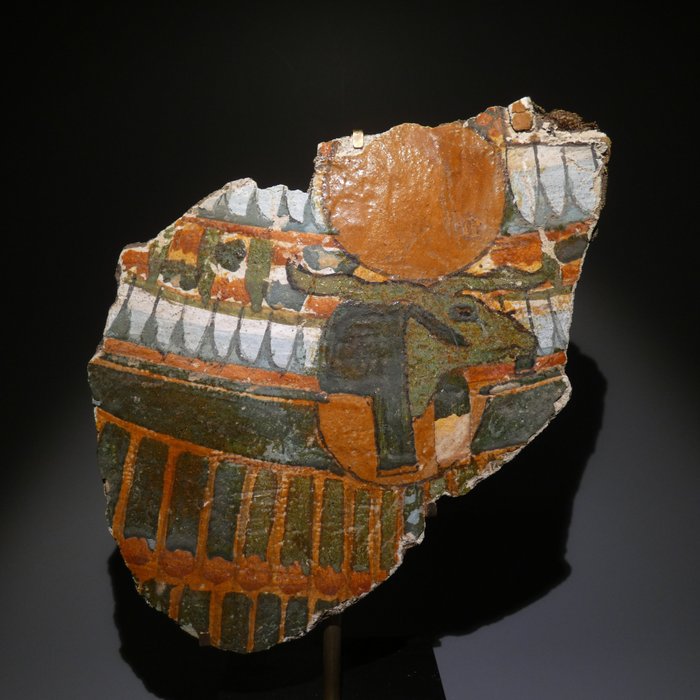
Oldtidens Egypten Fajance God Bes, Heqet frø og skarabé amuletter - 3.5 cm
Nr. 83784341

Nr. 83784341

Cartonnage fragment of a mummy with the god Khnum winged, god of fertility, associated with water and with procreation.
Ancient Egypt, Third Intermediate Period, 1070 - 650 BC
MATERIAL: Cartonnage
SIZE: 17 cm height and 16,5 cm width without stand, 22,5 cm height with stand.
PROVENANCE:
- Old label verso 'The British Embassy, The Hague', presumably from around 1900.
- Private collection, London.
- English auction sale of 14.4.2014,
- Private collection, Germay.
CONDITION: Good, see photos. Original pigments.
Khnum, ancient Egyptian god of fertility, associated with water and with procreation. Khnum was worshipped from the 1st dynasty (c. 2925–2775 BCE) into the early centuries CE. He was represented as a ram with horizontal twisting horns or as a man with a ram’s head. Khnum was believed to have created humankind from clay like a potter; this scene, with him using a potter’s wheel, was depicted in later times. The god’s first main cult centre was Herwer, near Al-Ashmūnayn in Middle Egypt. From the New Kingdom (1539–1075 BCE) on, however, he was the god of the island of Elephantine, near present-day Aswān, and was known as the lord of the surrounding First Cataract of the Nile River. At Elephantine he formed a triad of deities with the goddesses Satis and Anukis. Khnum also had an important cult at Esna, south of Thebes.
Cartonnage or cartonage is a type of material used in ancient Egyptian funerary masks from the First Intermediate Period to the Roman era. It was made of layers of linen or papyrus covered with plaster. Some of the Fayum mummy portraits are also painted on panels made of cartonnage.[2]
Notes:
The seller guarantees that he acquired this piece according to all national and international laws related to the ownership of cultural property. Provenance statement seen by Catawiki.
Sådan køber du hos Catawiki
1. Opdag noget særligt
2. Afgiv det højeste bud
3. Foretag en sikker betaling